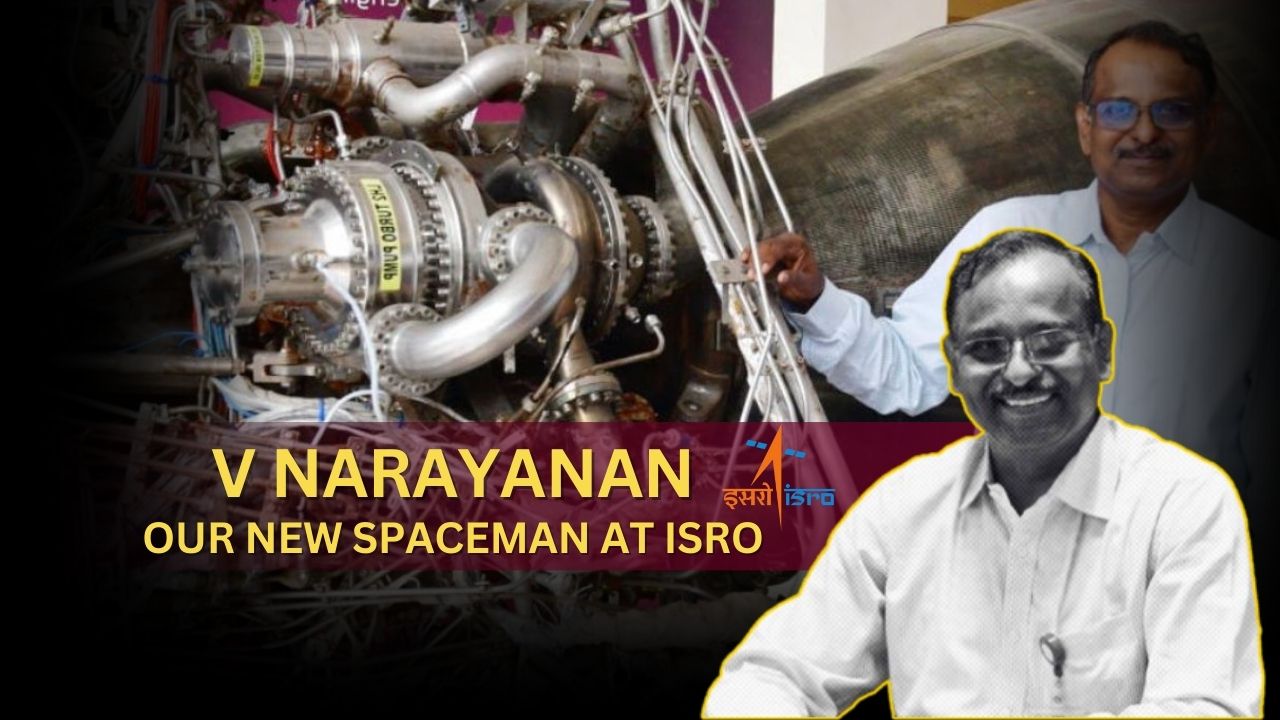

V Narayanan has been appointed as the new Chairman of the Indian Space Research Organisation (ISRO), effective January 14, 2025. He takes over from S Somanath, who has served as ISRO chief since January 2022. Narayanan's appointment is for a term of two year. In addition to leading ISRO, Narayanan will also serve as Secretary to the Department of Space and Chairman of the Space Commission. He has nearly four decades of experience at ISRO, an expert in rocket and spacecraft propulsion. He has contributed on developing several key propulsion systems for ISRO's launch vehicles.
Narayanan was born in 1964 in Melakattuvilai village near Nagercoil in Kanyakumari District, Tamil Nadu. He secured first rank in his Class 10 examinations. He then earned the first rank in the Diploma in Mechanical Engineering (DME) and achieved Associate Membership in Mechanical Engineering from the Institution of Engineers (AMIE). He went on to study at the Indian Institute of Technology (IIT) Kharagpur, where he earned his MTech degree in Cryogenic Engineering with First Rank in 1989. He later completed his Ph.D. in Aerospace Engineering from the same institution in 2001.
Narayanan joined ISRO in 1984. Prior to joining ISRO, he worked in the private sector for about a year and a half in Trichy and Ranipet. He worked for TI Diamond Chain Ltd., Madras Rubber Factory, and Bharat Heavy Electricals Limited (BHEL). At ISRO, he initially worked in the Solid Propulsion area for Sounding Rockets, Augmented Satellite Launch Vehicles (ASLV), and Polar Satellite Launch Vehicles (PSLV) at the Vikram Sarabhai Space Centre (VSSC). He contributed to process planning, control, and realization of ablative nozzle systems, composite motor cases, and composite igniter cases. He has been an integral part of developing the technology in the PSLV and LVM3 projects.
In 1989, after completing his M.Tech, Narayanan transitioned to the Cryogenic Propulsion area at the Liquid Propulsion Systems Centre (LPSC). He was one of the first few scientists to work on cryogenic engines at ISRO, carrying out fundamental research and experimental studies. His work was crucial in India's journey towards developing the capacity to build cryogenic engines indigenously. Narayanan played a key role in developing ISRO's indigenous Cryogenic Upper Stage (CUS) for GSLV MK-II. He also led the development of the C25 cryogenic stage for GSLV MK-III. As Project Director for the Geosynchronous Satellite Launch Vehicle Mark III (GSLV Mk III) C25 Cryogenic Project, he oversaw the team that created the C25 Cryogenic Stage, which uses liquid oxygen and liquid hydrogen to power a 20-ton thrust engine. With this, Narayanan was instrumental in making India the sixth country in the world to have cryogenic engine technology. Narayanan has also worked on many other important space missions, including the development of cryogenic propulsion systems for the Chandrayaan-2 and Chandrayaan-3 missions. He was the Chairman of the National Level Expert Committee that analyzed the Chandrayaan-2 landing and recommended improvements, contributing to the success of Chandrayaan-3.
In January 2018, Narayanan was appointed Director of the Liquid Propulsion Systems Centre (LPSC). As Director, he provided techno-managerial leadership for the development of Liquid, Semi-Cryogenic, and Cryogenic Propulsion Stages and control systems for launch vehicles, Chemical and Electric Propulsion Systems for Satellites, and Transducers for health monitoring. In his five years as LPSC Director, he has supplied 164 liquid propulsion systems for 41 launch vehicles and 31 spacecraft missions.
Narayanan's career at ISRO has been marked by a steady rise through the ranks. He started as a scientist working on solid propulsion systems and gradually moved to cryogenic propulsion1. He has held various key positions within ISRO, contributing to multiple high-profile missions and initiatives. These positions include:
His expertise in rocket and spacecraft propulsion has been instrumental in the success of many ISRO missions. As the Chairman of the Project Management Council-Space Transportation System (PMC-STS), responsible for making decisions for all programs and initiatives involving launch vehicles. One of his notable achievements was leading the Failure Analysis Committee for Chandrayaan 2, the mission where the Vikram Lander crashed. The analysis from this committee contributed significantly to the successful landing of Vikram at Shiv Shakti Point during the Chandrayaan 3 mission. His leadership and technical skills have earned him recognition within the organization and paved the way for his appointment as ISRO Chairman.
Narayanan's vision for ISRO includes expanding India's satellite presence, improving strategic and societal applications of space technology, and enhancing the country's contribution to global space exploration. He plans to steer ISRO into an era of greater global prominence and increase India's share in the global space economy from 2% to 10%. He also aims to foster deeper collaborations with international space agencies.
He acknowledges that while ISRO's development initially relied on collaborations with other space faring nations, the agency now commands global respect for its independent capabilities. With a clear roadmap for the future, including plans for missions to Mars and Venus, the development of the Bharatiya Antariksha Station (BAS), and the Gaganyaan human spaceflight program, Narayanan is poised to guide ISRO into a new era of space exploration.
V Narayanan's appointment as ISRO Chairman marks a new chapter in India's space program. His experience, technical expertise, and leadership skills make him well-suited to guide ISRO in its future endeavors.